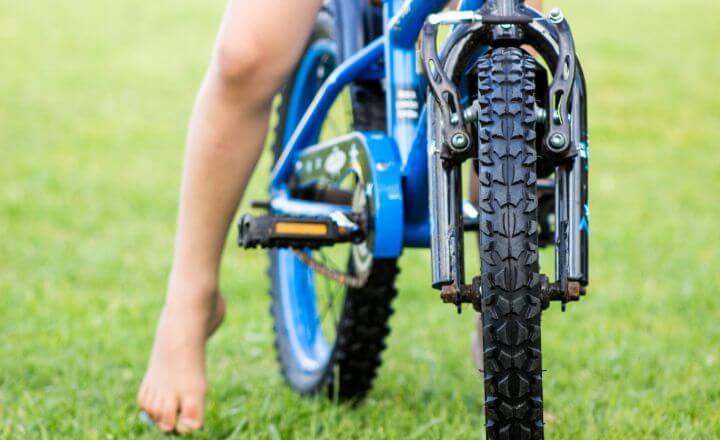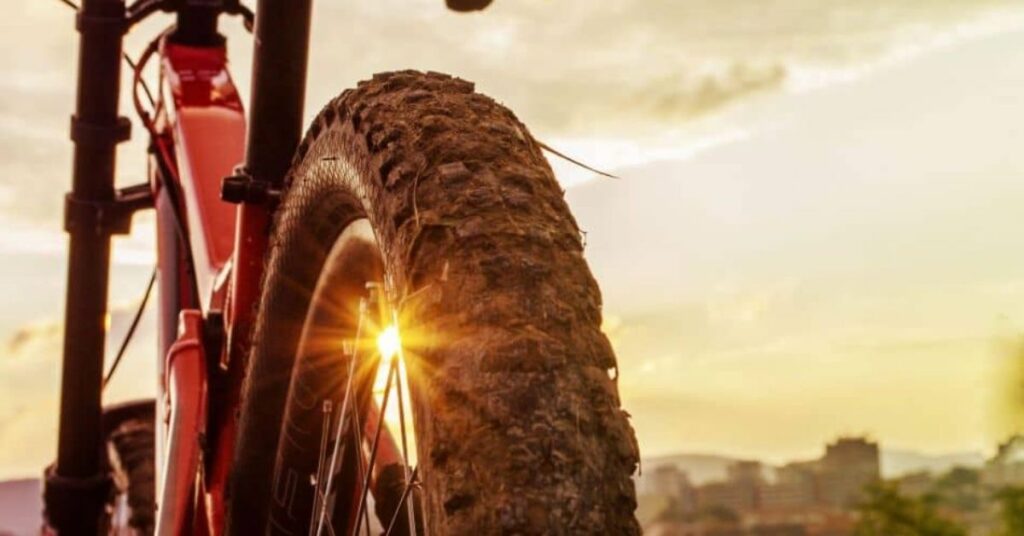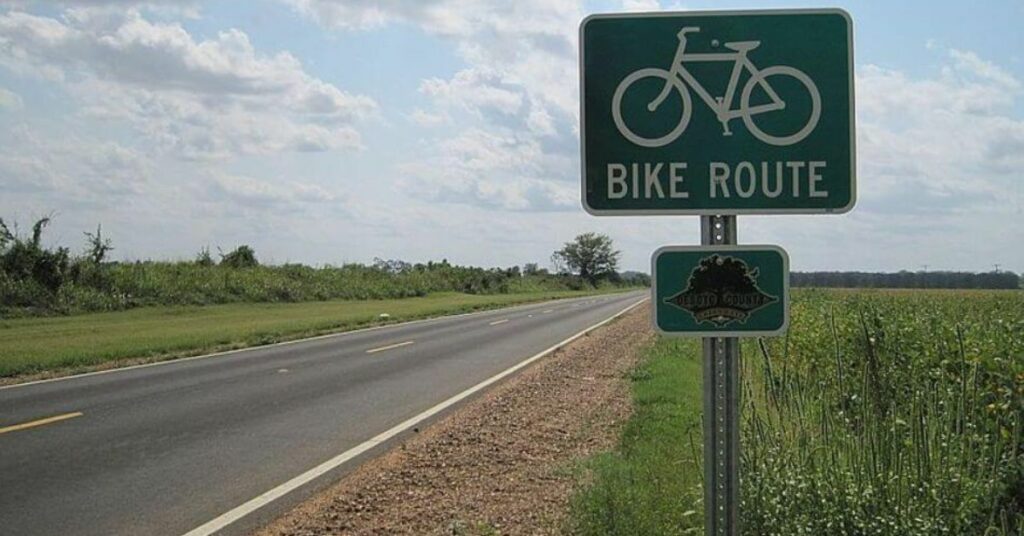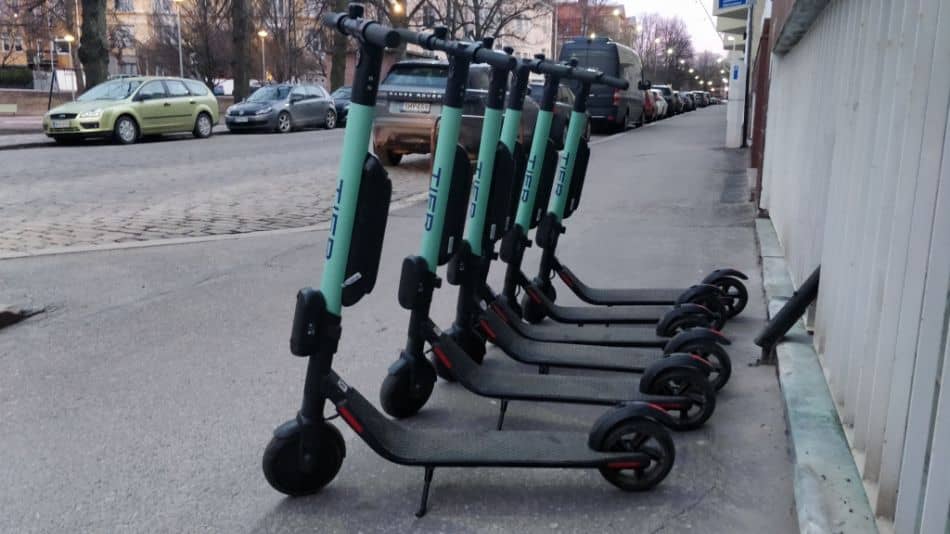(Last updated on March 2nd, 2023)
Do you check your tire pressure every time you ride? I do!
There is a sweet spot of tire pressure that helps me have a faster, safer, and more comfortable ride. And while many people overlook the importance of tire pressure, it must be something you consider on every bike ride.
This article will discuss everything you need to know about how much air goes in your bike tire. We’ll also go over the factors that determine your ideal tire pressure, give you some sample pressure ranges for different types of bikes, and tell you how to check your tire pressure.
But first, let’s talk about why it’s important to know how much air goes in your bike tire.
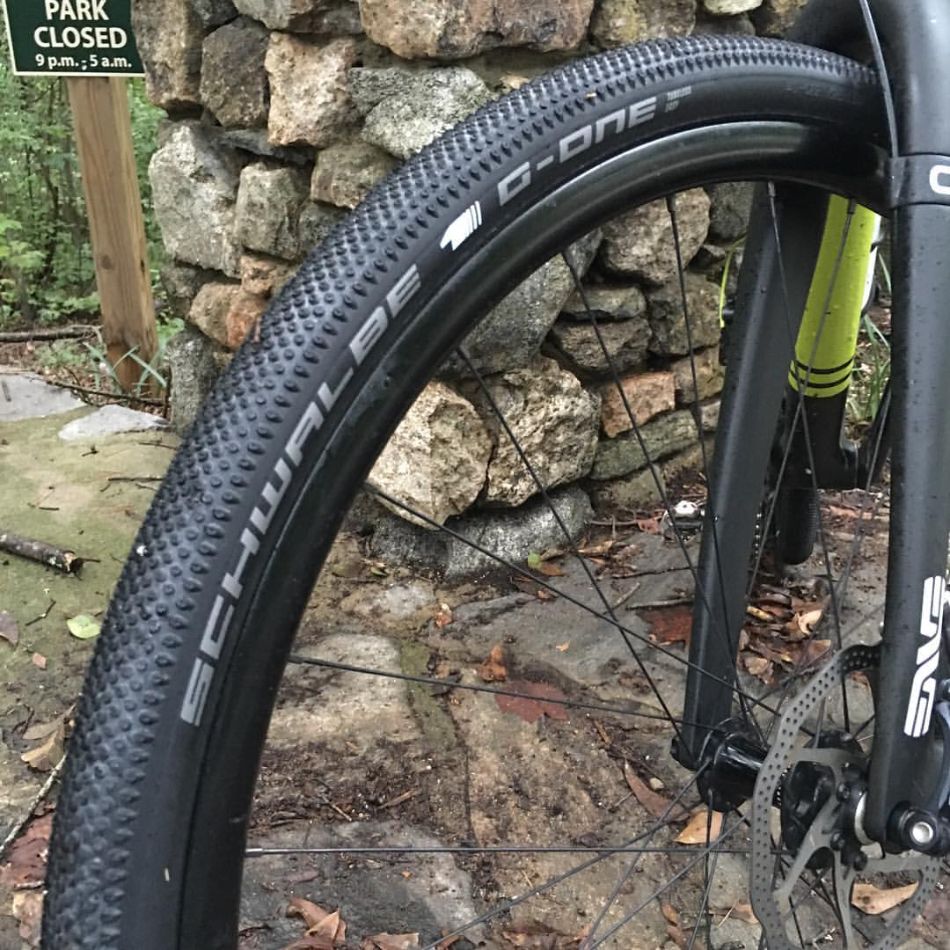
Why Your Bike Tire Pressure Is So Important
Getting the right amount of air in your bike tire is surprisingly important. The tire is what connects you and your bike to the road surface. The air pressure in your tires will impact how fast you go, how much grip your tires have on the road, the feel of the ride, and flats.
Speed
Getting the right air pressure in your tires affects your speed. There is a sweet spot that gives you the optimum speed. If tire pressure is too low, the tires will be pillowy and slow. On the other hand, if your tires are too high, they’ll bounce off of every bit of roughness in the road, which will also slow you down. Finding just the right pressure will give you the optimum speed. Si goes into detail about speed and tire pressure in this GCN video.
Traction
Tires with lower pressures will give you better traction on the road because more tires come in contact with the road surface anytime. Conversely, if your tire pressure is too high, there won’t be as much tire gripping the surface of the road, making you more likely to skid or slide, especially around turns or in wet weather.
Comfort
The lower the tire pressure, the more comfortable the ride. The higher the tire pressure, the more you’ll feel the uncomfortable vibrations from the road’s surface.
Flat Protection
If your tire pressures are too low, you’ll be much more likely to get a pinch flat. Similarly, if your pressures are too high, the tube or tire will be more likely to burst (very uncommon!), burp, or come off the rim if the tire is tubeless.
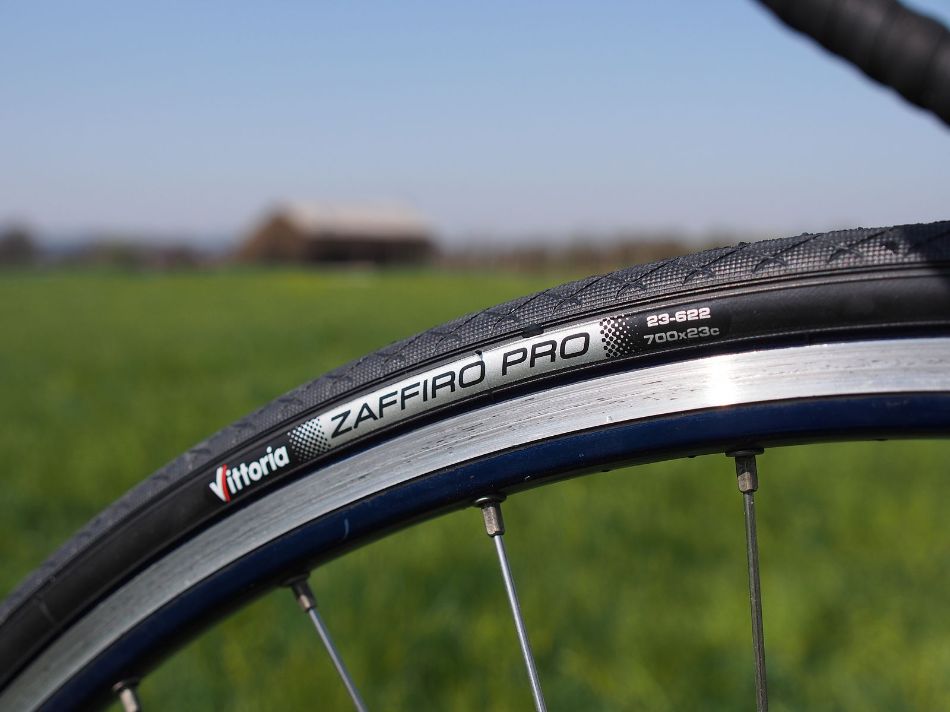
Factors That Affect Tire Pressure
Tubed Versus Tubeless
One factor determining your air pressure is whether or not you use tubes in your tires. Tires with tubes typically need a higher tire pressure than tubeless tires. Tubeless tires are designed to need less tire pressure. Tubeless tires with hookless rims can go even lower.
Wheel Width
The wider the wheel, the lower the tire pressure. The skinnier the wheel, the higher the tire pressure. This sounds like it would be counterintuitive, but it actually isn’t. It concerns the air volume in the tire, not the pressure.
A wider wheel can hold much more air, so it needs a lower tire pressure to get the necessary air volume. On the other hand, a skinnier wheel has a smaller volume of air inside of it, so it will need a higher tire pressure to get the right amount.
Rider Weight
A rider’s weight also affects that tire pressure. Heavier riders need more air in their tires, thus a higher tire pressure. And lightweight riders can use a lower tire pressure because they don’t need as much air in the tires.
Weather
In wet weather, the roads won’t have as much grip. So you’ll want to drop the tire pressure by about 5 or 10 PSI. This will give you a little more traction. But don’t go wild dropping your bike pressure, or you’ll end up with pinch flats.
Heat
Extreme heat can cause the air inside the tires to expand, so if you’re riding on extremely hot roads or descending quickly and have rim brakes, you’ll want to consider how much the air in your tire expands.
Terrain
Rougher terrain also calls for lower tire pressure. If you ride rough roads, you’ll typically want wider tires that naturally need lower tire pressure. But if you find yourself on your road bike with a rough surface, you can drop your tire pressure by about 5 or 10 PSI to give you more traction.
But, again, don’t go too far, or you’ll risk a pinch flat.
If all this sounds confusing and complicated, don’t worry. Here’s how to get it right.
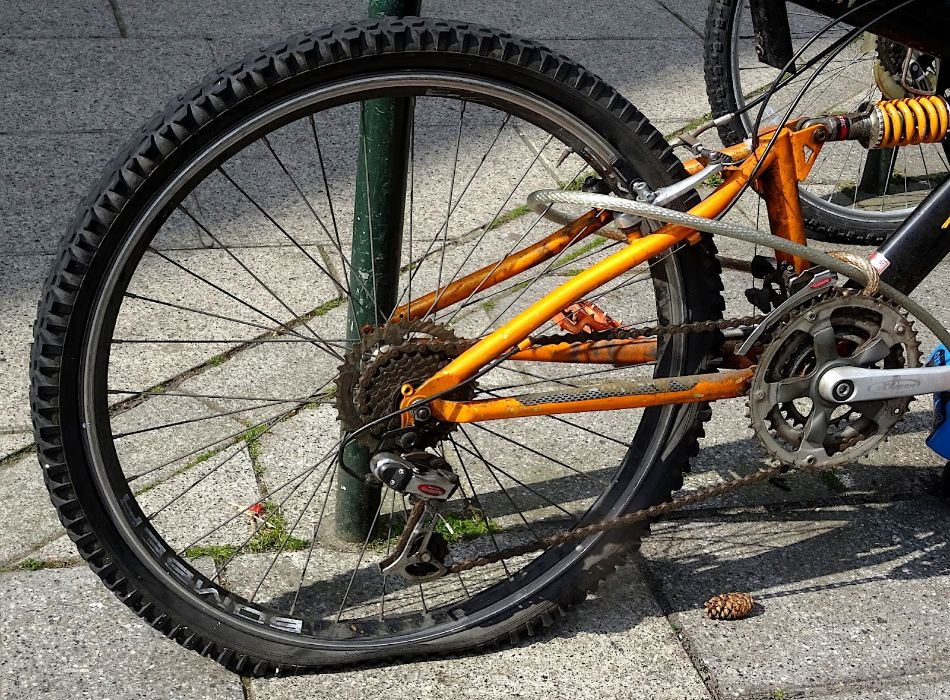
How to Find the Right Tire Pressure Range
Check the Tires’ Sidewall
The simplest way to find out what tire pressure you need in your bike tires is to look at the sidewall of the tires.
For example, I have a set of 25mm wide, 700c hooked Continental tubeless tires on my Quintana Roo. On the sidewall, it says max inflation 109 PSI. According to my local bike shop, a tire’s ‘burst pressure’ is typically double the max PSI, so as long as you follow the max pressure on the tire, you’ll be safe from it bursting.
The tires don’t say how low you can go, but they need enough air to protect against pinch flats. If you don’t have enough air in the tire, the rim can cut through the rubber, leaving you with a nasty gash.
I’m a lighter rider at around 50 kg, so I set my air pressure at around 72PSI. I could go just a bit lower than that in bad weather. If you had the same set-up but were heavier than I, you might want to take the air pressure up to 80 or 90PSI.
Riding a bike with tubed tires will give you a tire pressure range on the sidewall. For example, I have 25mm wide, 650C tubed Schwable tires on my Canyon Ultimate. The tire pressure range on the tire’s sidewall is 70 – 110 PSI. Unfortunately, 110 is too high for the roads I ride on, so I use 85 PSI on this bike. In rainy weather, I’ll drop the PSI to about 80.
Try the SRAM Tire Pressure Calculator
If you really want to get specific with tire pressure, check out SRAM’s tire pressure calculator. Fill in the details, and it will provide you with specific front and rear pressures based on factors such as your rims, tire width, weight, and bike weight.
Sample Recommended PSI for ICAN Road Bike Tires
| 23mm tubed | 25mm tubed | 28mm tubed | 23 mm tubeless | 25mm tubeless | 28mm tubeless | |
| 65 KG | 95/100 PSI | 90/95 PSI | 85/90 PSI | 90/95 PSI | 85/90 PSI | 80/85 PSI |
| 65-75GK | 100/105 PSI | 95/100 PSI | 90/95 PSI | 90/95 PSI | 85/90 PSI | 85/90 PSI |
| 75-85KG | 101/106 PSI | 96/101 PSI | 91/96 PSI | 95/98 PSI | 90/95 PSI | 85/90 PSI |
| 85-95KG | 104/109 PSI | 99/104 PSI | 94/100 PSI | 95/99 PSI | 90/95 PSI | 88/95 PSI |
This chart gives you a ballpark idea of the changes in tire pressure that you may see for different width tires and different weight riders. But these ranges are just for road bikes. So let’s look at the different types of bikes and riding disciplines and how they affect tire pressure.
Road Bike
Road bikes have skinny tires meant to be ridden on a paved road surface. So your road bike tires will probably range from 80 to 130 PSI. For racing, you’ll often find 90 to 100 PSI is standard.
Track Bike
A track bike is ridden on a smooth velodrome. Track bikes typically have skinny tires sewn onto the rim, making them extra strong. Track bike tire pressures usually fall between 120 and 250 PSI, depending on the type of tires and the type of velodrome. For example, an outdoor cement velodrome will use lower pressures, while an indoor wooden floor velodrome will use higher pressures.
Mountain Bike
Mountain bikes have very wide, grippy tires that are meant to be ridden on rough surfaces. Many mountain bike tire manufacturers recommend that mountain bike tires fall between 30 to 50 PSI, depending on the terrain. However, you may want to go as low as 22 PSI if you have wide tubeless tires with very rough terrain.
Gravel Bike
Gravel bike terrain falls in between road and gravel. So you’ll likely be riding with tubeless tires at pressures between 40 and 80 PSI. If you are lightweight and the roads are wet, you’ll want to stay towards the lower end. You’ll want to stay towards the higher end if you’re a bit heavier.
Cyclocross Bike
Traditional cyclocross tires are 33mm wide tubeless, knobby tires. If you have a really rocky and dry course, you might want these inflated to around 30 to 35 PSI. But if you find the course is rainy and muddy and you can’t get enough grip, your tubeless tires can go down to 15 to 20 PSI. Just be careful you don’t bottom out and get a flat.
On a rainy and wet course, I used 40 mm gravel tires set to 18 PSI and remained upright the entire time.
Hybrid Bike
The trouble with hybrid bikes is that everyone is different! You may have skinny, wide, tubed, or tubeless tires on your hybrid bike. Just be sure to check the sidewall and keep your pressure within the manufacturer’s recommendations.
Children’s Bike
Children’s bike wheels are typically very small but wide, so their tire pressure will differ from an adult bike. It’s always printed on the side of the tire, but you’ll probably find that it falls in a range of 20 to 40 PSI.
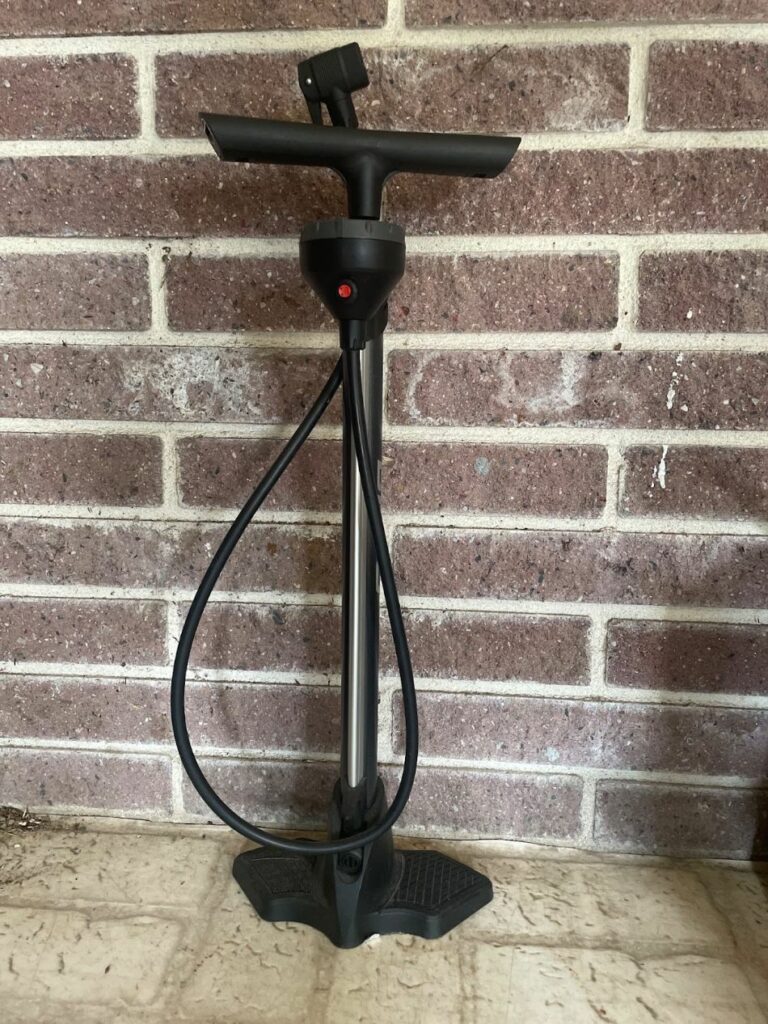
How to Check Your Bike Tire Pressure
As we already mentioned, you’ll find the recommended tire pressures printed right on the side of your tires. To check your tire pressure, you’ll need a bike tire pump that matches the type of valve on your tire or tubes.
This is either a Presta or a Schrader valve. Many pumps will incorporate both types.
- Remove the valve cap, and fit the pump head onto the valve.
- Pump the handle up and down several times until you get a good reading on the pump.
- From there, you can continue pumping to increase the pressure or push in the valve if you need to reduce the pressure.
Final Thoughts on How Much Air You Need in Your Bike Tires
Choosing the correct tire pressure will help you have a safer, faster, and more comfortable ride.
To find that ‘sweet spot’ of tire pressure, always start with the recommended pressures on the tire. Then, if you’re a heavier rider, you can go towards the higher end of the range (but never above). If you’re a lighter rider, like me, you can go towards the lower end of the range.
Then give it a test! See how it feels. Does the tire feel too mushy and slow? You may want to add a couple of PSI.
Does the tire feel too harsh and twitchy? You may want to drop a few PSI.
Eventually, you’ll find that sweet spot with the right combination of traction, speed, and comfort you like best. You may not be as fast as a motorcycle, but you’ll be able to optimize your speed.
Finally, check your tire pressure before every ride to ensure you have the optimal pressure.
Frequently Asked Questions
According to my local bike shop, a tire’s burst pressure is roughly double the max pressure on the sidewall. So if you go a little too high, you still won’t be likely to burst the tire.
However, your ride will have less traction, less comfort, and may be more likely to flat. So always stay within the appropriate range
A lower tire pressure is associated with more rolling resistance, which means you’ll have a slightly slower speed and a more comfortable ride. However, if your pressure is too low, you’ll be at a higher risk of pinch flats.
A pinch flat happens when there isn’t enough air in the tire. The tire then rolls under the rim, and the rim can slice the tube or the tire. You’ll typically see two small slits in the tube that look like a bite mark if you’ve got a pinch flat.
Keep your tire pressures high enough to protect against pinch flats.
Sort of. Higher tire pressures are associated with a lower rolling resistance, but depending on the width of the tire and the road surface, this may not make you faster. You’ll need to experiment to find the right balance.
You need a tire pump with a head that matches the valve on your tires. Some are Presta valves, and some are Schraeder. However, riding a track bike might need a special track pump because it can push a higher air pressure than a standard pump.
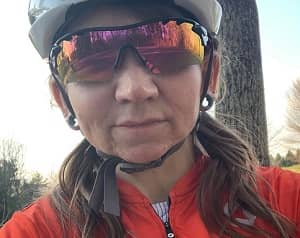
Amanda Whittington is an expert writer, impassioned cyclist, and musician. Coming from a diverse educational background, Amanda discovered a deep-rooted passion for encouraging others through her love of all things cycling, writing, and inspiring hope.
You’ll likely find Amanda pouring over bike specs, comparing the hottest cycling tech, and sporting the latest jerseys while juggling the demands of her editorial calendar, training schedule, tiny homestead, and 6 busy kids.
She spends her free time absorbed in her own gardening and fitness, cycling, and reading, all while encouraging adoption and foster care, championing the underdog, and of course, working with her chickens and goats.

